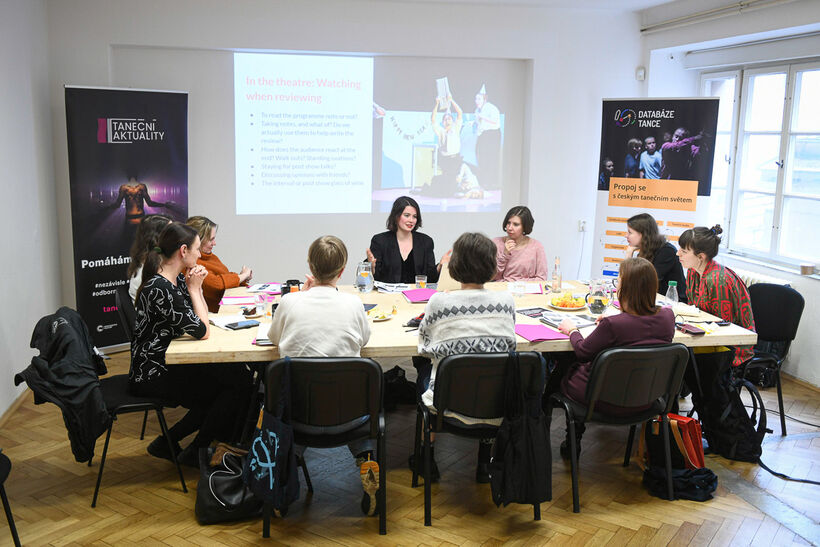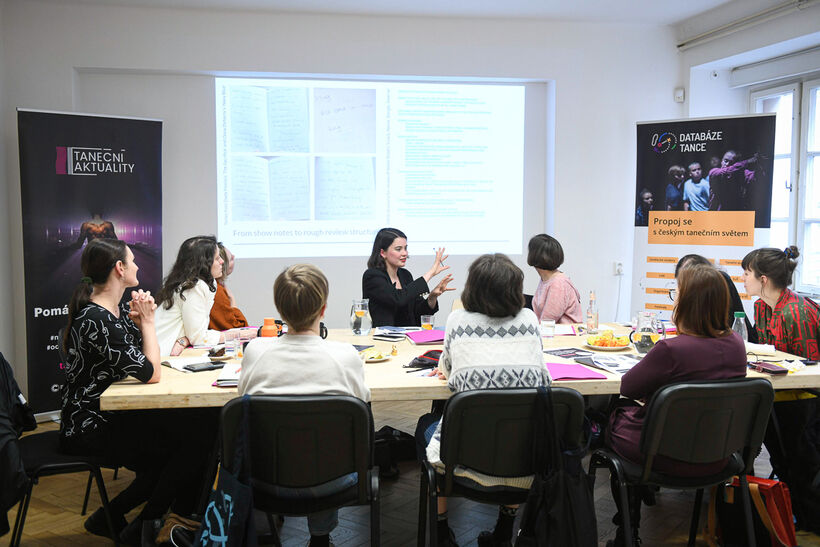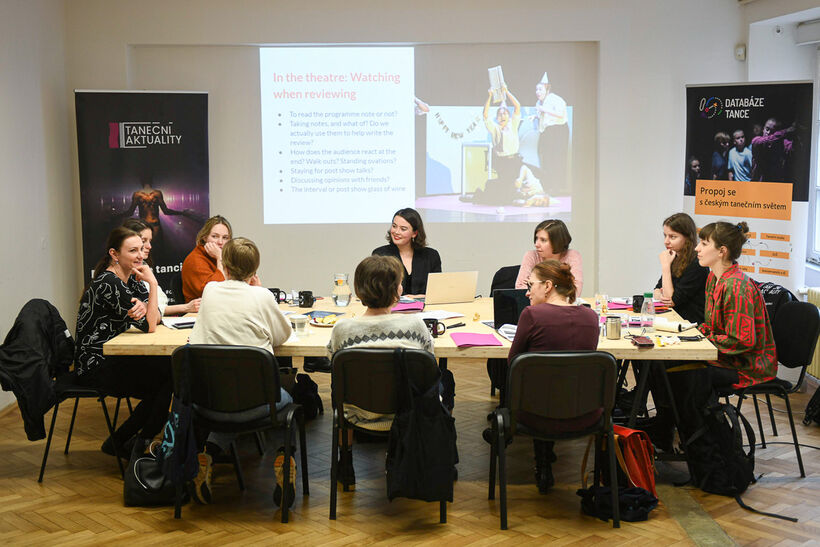While I’ve been writing dance reviews since 2016, at first I was worried that my approach was no different to anyone else's, and that what I presented would be common knowledge to all of the Czech and Slovak writers taking part. Throughout the process of preparing and conducting the workshop, however, I discovered that the methods writers use, and the challenges they face along the way, are extremely varied and personal, and there is a great deal to be gained from sharing our individual practices.
I kicked off the two-hour long session by sharing my personal motivations for writing about dance. Having originally trained at Trinity Laban Conservatoire in London, I began to focus on criticism half way through my degree, believing I could make more of a contribution to the industry through journalism than by being on stage myself.
In my view, dance writing is not merely a way of proclaiming a show to be good or bad, or to advise audiences whether they should go to see it. Instead, I write about dance…
● … to generate critical discourse. Roland Barthes’ ‘Death of the Author’ (1967) essay argues against traditional literary criticism's practice of relying on the intentions of an author to explain the definitive interpretation of a text. I believe this can be applied to dance writing. For me, dance criticism is an art form in its own right—one workshop participant interestingly said that they sometimes enjoy reading reviews more than watching actual shows—and an opportunity to explore feelings, reactions, make connections, and use art to talk about contemporary socio-political topics.
● … to advocate for dance as an art form. I often write about dance for visual art magazines and other mainstream publications with the hope of introducing the art form to new audiences. Writing in an accessible way can help to make people feel more comfortable to approach contemporary dance, which is often seen as niche or difficult to understand.
● … for posterity. Dance struggles to find its place in museums and history books due to its ephemerality. For me, criticism is a great method of documentation. Textual fragments can help researchers re-stage and reimagine works from the past that were never filmed. Aside from giving an impression of what a work looked like, reviews can also give insights into how a performance was received at the time.
.jpg)
The group of workshop participants largely agreed with these motivations, and on what constitutes a good dance review, which we discussed through sharing examples of texts we’d recently enjoyed reading. Positive features that came up ranged from a catchy opening hook and some contextual information, to the use of vivid metaphorical imagery, as well as compactness—reviews that aren’t too lengthy and that have a good ratio of opinion to description. This said, we agreed that opinion and description aren’t always separate things, and that the latter can be an effective way of artistically expressing your point of view.
One participant mentioned that they also like texts that pose questions, and—like Barthes promotes—don’t act as if they are the one definitive way a performance can be seen. As I believe that reviews are inherently subjective, and should give readers the scope to make up their own minds about a performance, I particularly enjoyed hearing this contribution. I was also interested to hear Anette Therese Pettersen’s anecdote about a critic who in one review conclusively proclaimed in a headline that one performance could not even be described as dance at all. Evidently, they were of a different mind than our working group in Prague. Later in the workshop, I summarised what we’d discussed into four key review elements:
● Setting the scene: giving background information and relevant context if necessary.
● Painting a picture: Vivid imagery and descriptions of (most importantly?) movement as well as lighting, costume, music, and setting etc.
● Deciphering meaning: Interpreting the imagery, messages, thoughts and emotions with your own subjective viewpoint.
● Giving your verdict: For you, did the piece achieve what it set out to do? Was it either enjoyable, skilful, emotive, engaging, thought provoking, or original?
Using our opening discussions as a basis, I began to detail my personal process of writing a review from inception right through to publication. Starting off with how I decide what I want to write about, I shared the questions I ask myself when considering pitching a show to a publication. These include “why does the show interest me?”, “is the choreographer one to watch, or an industry stalwart who is doing something new?”, “is the performance relevant or topical to current trends in the dance industry, other industries, or the wider world?”, and “am I the best person to write this piece?”
The last question prompted an interesting discussion around the fact that sometimes, even though you may not be the best, most specialised person to write about a certain work or dance style, if you don’t cover it, no one else will. This was particularly relevant for Czech, Hungarian, and Slovakian workshop participants who mentioned that the combination of overproduction and small number of active critics in their countries means that it's almost impossible to ensure that all shows get reviewed. The point was also raised that we don’t always get to decide what we want to write about, and are instead assigned performances by editors.
The next section of the workshop focused on the night of the performance, and how watching a show when reviewing differs from when you’re at the theatre purely for pleasure. Interestingly, this topic generated the most divergence of opinion. While Lena Megyeri said that she rarely reads programme notes, preferring to enter the auditorium with a clear mind, I like to glance over them to get an idea of the artist’s intention. This enables me to assess whether it comes across in the piece. I do, however, rarely attend post-show talks, in order to avoid being too influenced by the choreographer’s opinion before I start writing.
.jpg)
Lena and I also differed on our approach to taking notes. While Lena avoids it, I write avidly all the way through shows, and own copious notebooks filled with scribbled diagrams, floor plans and half-formed, often comical thoughts in wonky handwriting. Doing this is not just a way to remember choreographic details, but is mainly a method of putting my brain in a critical mindset. In fact, I barely use my notebook during the actual review writing process, only referring to it at the beginning to get an overview of my reactions and to draft a rough structure of everything I’d like to include in my text. Once I have this, I start writing at whichever point in the text that I find easiest—usually somewhere in the middle—to get me going to avoid writer's block. I find openings especially difficult, and they are the last thing I write. Other writers can’t get going with the rest of their reviews until they have a clear first paragraph locked in.
As they can be particularly tricky, we spent a good proportion of the workshop discussing openings and the different ways of writing them. Four approaches for openings we identified were:
● Informative openings—getting all the key information in the first paragraph
● Vivid openings—hooking the reader with engaging and sensory description
● Contextual openings—discussing a wider theme before honing in on the performance in question
● Referential openings—using a relevant quote from an artist or book that leads into points that you’re going to make later on
Generally, all the workshop participants agreed that experimental, vivid openings are more engaging than informative ones. Sometimes the latter are unavoidable, as it is necessary to give your reader all the key information so that they can understand what you’re going to talk about later. When taking a more artistic approach, it’s also important that you quickly—preferably in the second paragraph—give your reader all the basic show information they need. If not, you run therisk of writing a whole review and forgetting to mention the title of the piece or the name of the choreographer!
Next, we delved deeper into ways of describing movement, identifying verbs and adverbs, also known as “action words”, as the dance writer’s natural best friends. These are closely followed by metaphors, similes, and comparisons—if the readers weren’t at the show, the text should relate to something they may be familiar with to help them picture it. Specificity about which body part is moving and how it’s moving is also important. Studying Laban’s effort theories during my degree very much helped me with describing movement dynamics, however during the workshop we agreed that it is important not to use highly specialised vocabulary in dance reviews, as it makes your text less accessible for readers who are new to dance. One participant raised the point that this includes resisting the temptation to employ at times useful, but not universally known, balletic terminology.
.jpg)
The last aspect of the writing process we addressed in detail was forming and expressing opinion. Here, we mainly focused on the importance of the following points…
● Staying true to your thoughts regardless of what you’ve heard other people say
● Focusing on the work itself rather than people in order to avoid getting too personal or critical of individual dancers—this point raised a discussion about how it is sometimes nice to recognise individual performers and the artistic contribution they make to the success of a piece, especially if their performance is more arresting than the choreography itself
● Evaluating the work on its own terms (e.g., not trying to judge a hip-hop piece like a classical ballet)
● Being careful not to make suggestions, e.g., how you would have done it if you were a choreographer, or what you’d liked to have seen instead
● Not confusing criticality with being mean or negative
● Being aware of personal biases
● Being clear that a review is “one critic’s opinion”, not a universal truth
… before delving into a discussion about the inclusion of the first person in dance reviews. In my opinion using “I” is completely acceptable in criticism. This said, there are certain questions a writer should ask themselves when considering using “I” or including personal anecdotes in a piece. For me, the main one is: “is including myself at the service of illuminating the dance performance in question?”
To close the workshop, we covered what happens when the writing process is over, addressing points including the importance of spell and fact checking, working on feedback, sharing your work on social media, and most importantly, developing a relationship with editors. This is sadly not always possible: a number of workshop participants identified that, due to quick turnaround times, some editors often put up pieces without editing them at all. Others make changes without having a back and forth with the writer, prohibiting them from learning and growing.
While we may not be able to change this in the short term, hopefully supplementary activities—such as these workshops run by Czech Dance News—can help writers to evolve their practices, and meet like-minded critics with whom to exchange ideas and perspectives. The process of conceptualising and delivering my workshop, and engaging in dialogue with other writers from across Europe, certainly impacted mine… and abated a small amount of my aforementioned imposter syndrome!
Editor's note: This text was written as part of the project Dance Criticism in a European Context. The project was supported by the European Union and the Ministry of Culture through the National Recovery Plan.




.jpg)
.jpg)
.jpg)
